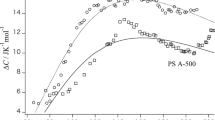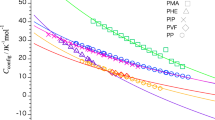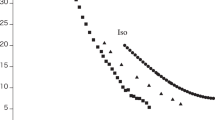Abstract
In this study, we investigated the functions that reproduce the configurational heat capacity (Cconfig) above the glass transition temperature for polystyrene (PS), polyisobutylene (PIB), and their oligomers. The results show that Cconfig can be well reproduced using the power and logarithmic functions based on Landau theory, which explains the vicinity of the critical point. The power and logarithmic functions had four and three fitting parameters, respectively. The error ranges were ~±2% for PS and ±5% for PIB.
This is a preview of subscription content, access via your institution
Access options
Subscribe to this journal
Receive 12 print issues and online access
$259.00 per year
only $21.58 per issue
Buy this article
- Purchase on Springer Link
- Instant access to full article PDF
Prices may be subject to local taxes which are calculated during checkout









Similar content being viewed by others
References
Wagman DD, Evans WH, Parker VB, Schumm RH, Halow I, Bailey SM. The NBS tables of chemical thermodynamic properties: Selected values for inorganic and C1 and C2 organic substances in SI units. J Phys Chem Ref Dat. 1982;11:1–392.
Gopal ESR. Specific heats at low temperatures. London: Springer, 2012.
Wunderlich B. Thermal analysis of polymeric materials. Springer, Heidelberg; 2005.
Glassy, amorphous and nano-crystalline materials: thermal physics, analysis, structure and properties. In: Šesták J, Mareš JJ, Hubík P, editors. Hot topics in thermal analysis and calorimetry. vol. 8. Springer Science & Business Media; 2010.
Gibson GE, Giauque WF. The third law of thermodynamics. Evidence from the specific heats of glycerol that the entropy of a glass exceeds that of a crystal at the absolute zero. J Am Chem Soc. 1923;45:93–104.
Haida O, Matsuo T, Suga H, Seki S. Calorimetric study of the glassy state X. Enthalpy relaxation at the glass-transition temperature of hexagonal ice. J Chem Thermodyn. 1974;6:815–25.
Tajima Y, Matsuo T, Suga H. Calorimetric study of phase transition in hexagonal ice doped with alkali hydroxides. J Phys Chem Solids. 1984;45:1135–44.
Jianye W. Heat capacities of polymers in physical properties of polymers handbook. In: James E. Mark, editor. Chapter 9. New York: Springer; 2007. p. 145–54.
Domalski ES, Hearing ED. Heat capacities and entropies of organic compounds in the condensed phase. Volume III. J Phys Chem Ref Data. 1996;25:1–525.
Pyda M, Bartkowiak M, Wunderlich B. Computation of heat capacities of solids using a general Tarasov equation. J Therm Anal. 1998;52:631–56.
Wunderlich B. Motion in polyethylene. II. Vibrations in crystalline polyethylene. J Chem Phys. 1962;37:1207–16.
Pyda M, Nowak-Pyda E, Mays J, Wunderlich B. Heat capacity of poly (butylene terephthalate). J Polym Sci. 2004;42:4401–11.
Yoshida S, Suga H, Seki S. Thermodynamic studies of solid polyethers. II. Heat capacity of poly(oxacyclobutane), –[–(CH2)3O–]– n, between 1.4 and 330°K. Polym J. 1973;5:11–24.
Yoshida S, Suga H, Seki S. Thermodynamic studies of solid polyethers. III. Poly(tetrahydrofuran), –[–(CH2)4O–]–n. Polym J. 1973;5:25–32.
Yoshida S, Suga H, Seki S. Thermodynamic studies of solid polyethers. IV. Poly(octamethylene oxide), –[–(CH2)8O–]–n. Polym J. 1973;5:33–40.
Yokota M, Nishiyama E, Fujimura J, Tsukushi I. Excess heat capacity for low-molecular-weight amorphous polystyrene below the glass-transition temperature: influence of end groups. Polym J. 2020;52:575–80.
Yokota M, Sugane K, Tsukushi I, Shibata M. Evaluation of the heat capacity of amorphous polymers composed of a carbon backbone below their glass transition temperature. Polym J. 2020;52:765–74.
Yokota M, Tsukushi I. Heat capacities of polymer solids composed of polyesters and poly(oxide)s, evaluated below the glass-transition temperature. Polym J. 2020;52:1103–11.
Einstein A. Die Plancksche Theorie der Strahlung und die Theorie der spezifischen Wärme. Ann der Phys. 1907;327:180–90.
Tarasov VV, Yunitskii GA. Theory of heat capacity of chain and layer structures. Russ J Phys Chem. 1965;39:1109–11.
Debye P. Zur Theorie der spezifischen Wärmen. Ann der Phys. 1912;344:789–839.
Yokota M, Tsukushi I. Prediction of the heat capacity of main-chain-type polymers below the glass transition temperature. Polym J. 2020;52:1113–20.
Nishiyama E, Yokota M, Tsukushi I. Estimation of the configurational heat capacity of polyisobutylene, isobutane and 2,2,4-isomethylpentane above the glass transition temperature. Polym J. 2021;53:1031–6.
Yamamuro O, Tsukushi I, Lindqvist A, Takahara S, Ishikawa M, Matsuo T. Calorimetric study of glassy and liquid toluene and ethylbenzene: thermodynamic approach to spatial heterogeneity in glass-forming molecular liquids. J Phys Chem B. 1998;102:1605–9.
Tatsumi S, Aso S, Yamamuro O. Thermodynamic study of simple molecular glasses: universal features in their heat capacity and the size of the cooperatively rearranging regions. Phys Rev Lett. 2012;109:045701.
Gaur U, Wunderlich B. Heat capacity and other thermodynamic properties of linear macromolecules. V. Polystyrene. J Phys Chem Ref Data. 1982;11:313–25.
Schottky W. The rotation of atomic axes in solids (with magnetic, thermal and chemical applications). Physikalische Z. 1922;23:448–55.
Kadanoff LP, Götze W, Hamblen D, Hecht R, Lewis EAS, Palciaus VV, et al. Static phenomena near critical point: theory and experiment. Rev Mod Phys. 1967;39:395–431.
Acknowledgements
The authors would like to thank Enago (www.enago.jp) for the English language review.
Author information
Authors and Affiliations
Corresponding author
Ethics declarations
Conflict of interest
The authors declare no competing interests.
Additional information
Publisher’s note Springer Nature remains neutral with regard to jurisdictional claims in published maps and institutional affiliations.
Rights and permissions
About this article
Cite this article
Nishiyama, E., Yokota, M. & Tsukushi, I. Analysis of the configurational heat capacity of polystyrene and its monomer and oligomer above the glass transition temperature. Polym J 54, 33–39 (2022). https://doi.org/10.1038/s41428-021-00554-3
Received:
Revised:
Accepted:
Published:
Issue Date:
DOI: https://doi.org/10.1038/s41428-021-00554-3
This article is cited by
-
Configurational heat capacity of various polymers above the glass transition temperature
Polymer Journal (2022)



